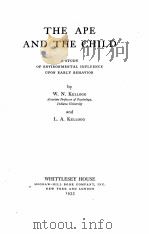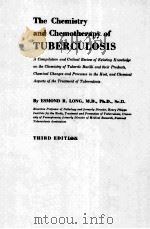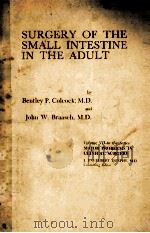《Tuberculosis in The Child And The Adult》
| 作者 | Francis Marion Pottenger 编者 |
|---|---|
| 出版 | The C.V.Mosby Company |
| 参考页数 | 611 |
| 出版时间 | 1934(求助前请核对) 目录预览 |
| ISBN号 | 无 — 求助条款 |
| PDF编号 | 818063038(仅供预览,未存储实际文件) |
| 求助格式 | 扫描PDF(若分多册发行,每次仅能受理1册) |

CHAPTER ⅠTHE DECLINE IN TUBERCULOSIS17
Tuberculosis a Preventable and Curable Disease17
The Decline in Tuberculosis17
Tuberculosis of the Present21
Tuberculosis of the Past23
Steps in Progress24
Sanatorium Treatment28
Foundation of Rest Treatment28
Factors Which Are Aiding Progress29
CHAPTER ⅡTHE FORMATION AND AFTER-COURSE OF THE PRIMARY LESION34
Source of Infecting Bacilli34
Dissociation Forms of Tubercle Bacilli35
Routes of Infection37
General Defense of the Body Against Tubercle Bacilli38
The Local Cellular Reaction to the Tubercle Bacillus39
Location of the Primary Lesion40
Results of Primary Infection41
Extension of the Primary Complex45
Healing of Primary Tubercle46
CHAPTER ⅢTHE HOST'S RESPONSE TO REINOCULATION OF TUBERCLE,BACILLI50
Koch's Phenomenon50
Further Experimental Studies Establishing Immunity in Tuberculosis52
Influence of Dosage and Virulence of Bacilli Upon Patient's Reactions54
The Reactive Phenomena to Reinoculation56
Endogenous and Exogenous Sources of Bacilli of Reinfection63
The Relationship of Bacillemia to Reinfection and Clinical Tuberculosis65
Bronchogenic Route of Reinfection.Its Relationship to Clinical Tuberculosis67
Relationship of Contiguous Reinfections to Clinical Tuberculosis68
Relationship of Lymphatic Reinfection to Clinical Tuberculosis69
CHAPTER ⅣCHILDHOOD TUBERCULOSIS73
Infection73
Frequency of Tuberculous Infection in Childhood73
Factors Which Predispose the Child to Infection76
Of What Does the Primary Infection Consist78
Latent Tubercle Bacilli78
Latent Primary Lesions79
Methods of Diagnosing the Primary Focus79
Effect of Healed Lesions on the Child83
The Effects of Unhealed Lesions on the Child87
CHAPTER ⅤCHILDHOOD TUBERCULOSIS(CONT'D)90
Tuberculous Disease90
The Pulmonary Component of the Primary Complex90
The Glandular Component of the Primary Complex90
Difference in Tuberculous Lesions According to Age Periods93
Symptomless Course of Unhealed Primary Complex98
Symptoms Which May Be Caused by Incompletely Encapsulated Primary Complex99
Metastases in Childhood104
Active Tuberculosis in Childhood105
Epituberculosis116
Temperature120
Height Weight and Tuberculosis122
Emotional State of Child122
Prognosis in Incompletely Healed Primary Complex123
Treatment of Active Primary Complex123
Best124
How to Determine the Amount of Rest Required125
Food126
Cod Liver Oil128
Viosterol128
Heliotherapy129
Tuberculin131
Psychologic Aspects of Treatment132
Where Shall Such Children Be Treated132
CHAPTER ⅥIMMUNIZATION AGAINST TUBERCULOSIS134
The Prevention of Childhood Infections by Immunization134
CHAPTER ⅦFACTORS IN THE DEVELOPMENT OF THE ADULT TYPE OF TUBERCULOSIS140
Adult Type of Tuberculosis Defined140
Factors Which Favor Development of the Adult Type of Tuberculosis140
Changes in Previous Foci141
Effect of Other Diseases142
Physiochemical Change142
Changes in Nutritional Requirements of Bacilli143
Occupational Factors143
Constitutional Factors Which Favor Tuberculous Disease144
Accidental Factors Favoring Reinoculation145
What Causes Diagnostic Phenomena146
Minimal and Subminimal Infections147
Pathologic Characteristics of Adult Tuberculosis148
Proliferative Lesions148
Exudative Lesions149
Atelectasis150
Cavity151
Miliary Tuberculosis159
CHAPTER ⅧTHE VISCERAL NEUROLOGY OF PULMONARY TUBERCULOSIS102
The Vegetative Nervous System162
Embryologic Relationships of the Lungs164
Segmental Relationships of the Lungs166
Segmental Relationships of the Pleura168
Reflexes Produced in the Lungs,the Stimuli Arising Elsewhere in the Body168
Asthma169
Massive Collapse or Pulmonary Atelectasis169
Bronchitis172
The Lungs as Affected by Sympathetic Reflexes and Substances Whose Action Simulates Stimulation of the Sympathetics172
Manner in Which Visceral Structures Are Affected by Toxins of Pulmonary Tuberculosis173
Manner in Which Visceral Structures Are Reflexly Affected by the Allergic Inflammatory Reaction Due to Pulmonary Tuberculosis175
Distribution of Pulmonary Reflexes176
Distribution of Pleural Reflexes177
CHAPTER ⅨTHE VISCERAL NEUROLOGY OF PULMONARY TUBERCULOSIS(CONT'D)180
Classification of Reflexes Which May Be Caused by Pulmonary Tuberculosis180
Viscerosomatic Reflexes Caused by Afferent Impulsus Which Course With the Sympathetica181
Reflex Spasticity Expressed in the Muscles of the Shoulder Girdle and Diaphragm183
The Trophic Reflex in the Somatic Tissues Caused by Stimuli Arising in the Lung185
The Sensory Reflex From the Lung188
Flushing of the Face and Ear189
Visceroskeletal Reflexes of Parasympathetic Origin189
Spasm of the Sternocleidomastoideus and Trapezius191
Flushing of the Face191
Motor and Trophic Effects in the Facial Muscles191
Motor and Trophic Reflexes in the Tongue191
Sensory Phenomena About the Head and Face192
Viscerovisceral Reflexes in Which Both Afferent and Efferent Fibers Course With the Sympathetics193
Dilatation of Pupil194
Tachycardia195
Inhibition of Motility and Secretory Activity in the Gastrointestinal Tract195
Increased Activity in the Sphincters196
Viscerovisceral Reflexes in Which Both Afferent and Efferent Fibers Belong to the Parasympathetic System196
Effects in the Nasopharyngeal Structures197
Reflex Disturbance in the Larynx198
Cough199
Reflexes in the Gastrointestinal Tract199
Reflex Effects Shown in the Heart200
CHAPTER ⅩDIAGNOSIS OF PULMONARY TUBERCULOSIS207
The Clinical History and Symptomatology207
Necessity of Accurate Study of the Patient and His Reactions207
Importance of Clinical History208
History of Tuberculous Illness209
Masquerading Syndromes of Early Tuberculosis210
Allergy the Cause of Symptoms212
Etiologic Classification of Symptoms212
Evaluation of Symptoms215
Symptoms of Toxemia216
Reflex Symptoms223
Local Symptoms or Symptoms Caused by the Tuberculous Process Per Se226
CHAPTER ⅪDIAGNOSIS OF PULMONARY TUBERCULOSIS(CONT'D)232
Examination of the Chest:Inspection232
General Inspection232
Inspection of the Chest233
Normal Chest233
Changes Due to Right-or Left-Handedness235
Size,Contour,and Shape of the Chest236
Pathologic Forms of the Chest236
Change in Motility of Chest an Indication of Pathologic Changes Within237
Lessened Motility Due to Previous Pathology in the Lung and Pleura237
Reflex Lessened Motility of Thorax in Active Tuberculosis238
Reflex Degeneration of Skin,Subcutaneous Tissue,and Muscles Resulting From Pulmonary Inflammation240
Reflex Degeneration of Skin,Subcutaneous Tissue and Muscles Resulting From Pleural Involvement241
CHAPTER ⅫDIAGNOSIS OF PULMONARY TUBERCULOSIS(CONT'D)245
Examination of Chest:Palpation245
How Does Palpation Give Diagnostic Information in Pulmonary Tuberculosis245
The Detection of Pulmonary Reflexes by Palpation246
The Pulmonary Motor Reflex247
How to Palpate Muscles for the Detection of the Pulmonary Motor Reflex248
Lagging of the Side248
The Pulmonary Trophic Reflex249
Pleural Trophic Reflex250
The Detection of Different Densities in the Thorax by Palpation252
CHAPTER ⅩⅢDIAGNOSIS OF PULMONARY TUBERCULOSIS(CONT'D)256
Examination of Chest:Percussion256
Value of Percussion256
Chests Cannot Be Standardized for Percussion256
Character of Percussion Stroke257
Common Errors in Percussion257
Apical Contraction260
Effect of Apical Muscles on Percussion261
Diagnostic Value of Percussion261
CHAPTER ⅩⅣDIAGNOSIS OF PULMONARY TUBERCULOSIS(CONT'D)263
Examination of Chest:Auscultation263
Causes of Auscultatory Phenomena in Pulmonary Tuberculosis263
Changes Due Directly to the Inflammatory Reaction in the Lung263
Changes Due to the Condition of the Muscles264
Importance of Auscultation265
How to Carry Out Auscultation266
Respiratory Sounds in Early Tuberculosis267
Why Respiratory Sounds Differ in Early Tuberculosis268
Rales269
Origin of Rales or Adventitious Sounds270
CHAPTER ⅩⅤDIAGNOSIS OF PULMONARY TUBERCULOSIS(CONT'D)275
X-ray of the Chest275
Diagnostic Evidence Revealed by the X-ray275
Why the X-ray May Pail to Show Tuberculous Lesions275
Roentgen Ray Shadows Depend on the Chemical Composition of Tissues276
Error Due to Vertical Plane in Which Chest Pathology Is Found278
Avoidable Errors of Technic279
Relation of Allergy to Shadows on the X-ray Film279
Place of X-ray in Diagnosis283
Normal Chest Film284
The X-ray Diagnosis of the Primary Complex284
The Value of the X-ray in Diagnosis of Adult Tuberculosis286
The Use of the Fluoroscope287
CHAPTER ⅩⅥDIAGNOSIS OF PULMONARY TUBERCULOSIS(CONT'D)292
Examination for Tubercle Bacilli292
The Relation of Bacillus Bearing Sputum to the Pulmonary Lesion292
The Part of the Tubercle Bacillus in Diagnosis295
Meaning of the Cellular Content of Sputum295
Instructions for Collecting Sputum for Examination298
Methods of Concentration in Sputum Examination298
The Dilution-Flotation Picric Acid Method299
CHAPTER ⅩⅦDIAGNOSIS OF PULMONARY TUBERCULOSIS(CONT'D)303
Tuberculin Tests303
What Is Meant by Positive or Negative Reactions in Diagnosis303
Nature of Tuberculin Reaction307
Subcutaneous Tuberculin Test309
Cutaneous Tuberculin Test312
The Intradermal Test314
The Percutaneous Test of Moro316
CHAPTER ⅩⅧTHE BLOOD REACTION IN TUBERCULOSIS318
Erythropoietic System318
The Leucocytic System319
Relative Percentage of Lymphocytes in Peripheral Blood320
Sedimentation Hate of Bed Corpuscles320
The Schilling Hemogram321
CHAPTER ⅩⅨCOMPLICATIONS OR PULMONARY TUBERCULOSIS325
Tuberculous Laryngitis325
Larynx Ideal Place to Observe Tuberculous Process325
Method of Invasion326
Diagnosis326
Cough327
Increased Secretion327
Obstruction328
Differential Diagnosis328
Treatment329
CHAPTER ⅩⅩCOMPLICATIONS OR PULMONARY TUBERCULOSIS(CONT'D)331
Tuberculosis of the Intestine331
Incidence of Intestinal Infection331
Method of Infection331
Diagnosis of Intestinal Tuberculosis332
Diarrhea332
Temperature333
Weight333
Physical Examination333
X-ray333
Blood in Stool333
Prophylaxis334
Prognosis334
Treatment335
Fistula in Ano337
CHAPTER ⅩⅪCOMPLICATIONS OF PULMONARY TUBERCULOSIS(CONT'D)340
Pleurisy340
Pleurisy as a Sign of Early Tuberculous Infection340
Pleurisy in the Course of Pulmonary Tuberculosis341
The Site of Pleurisy344
Pleurisy at the Base With Pain Radiating Over Abdomen345
Other Causes of Pleural Effusion346
Nature of Effusions347
Microscopic Study of Effusions348
Diagnosis of Pleurisy348
Recurrent Pleural Pain349
Treatment of Pleurisy350
Treatment of Tuberculous Empyema351
Treatment of Nontuberculous Empyema351
Treatment of Empyema by Closed Drainage352
CHAPTER ⅩⅫCOMPLICATIONS OF PULMONARY TUBERCULOSIS(CONT'D)356
Pulmonary Hemorrhage356
Diseases Commonly Accompanied by Hemorrhage356
Cause of Pulmonary Hemorrhage in Tuberculosis356
Factors Which Induce Hemorrhage358
Treatment of Pulmonary Hemorrhage359
Diet in Hemorrhage363
Constipation364
CHAPTER ⅩⅩⅢMAJOR PATHOLOGIC PROCESSES IN TUBERCULOSIS365
Proliferation366
Exudation368
Caseation370
Cavity371
Calcification372
CHAPTER ⅩⅩⅣTREATMENT OF TUBERCULOSIS375
Certain Principles Which Underlie the Successful Treatment of Tuberculosis375
Pathologic Evidence of Healing375
Small Lesions Heal Most Readily375
Is There a Benign Tuberculosis376
How Lesions Heal378
Why Lesions Fail to Heal381
Why Treat Tuberculosis381
When Should Tuberculosis Be Treated381
How Should Tuberculosis Be Treated385
Psychology of the Tuberculous Patient386
Technic of Treatment387
Segregation and Control of the Patient388
Who Shall Treat Tuberculosis389
Where Shall Tuberculosis Be Treated389
Home Treatment391
Individuality in Treatment391
CHAPTER ⅩⅩⅤTREATMENT OF PULMONARY TUBERCULOSIS393
Open Air393
Effects of Open Air393
How to Obtain the Benefits of Open Air394
Increased Cleanliness of Open Air395
Clothing May Increase or Decrease Benefits of Open Air396
CHAPTER ⅩⅩⅥTREATMENT OF PULMONARY TUBERCULOSIS(CONT'D)398
Rest and Exercise398
Physiology of Rest and Exercise399
Food Requirements of Rest and Exercise400
Oxygen Requirements of Rest and Exercise400
Circulatory Requirements of Rest and Exercise401
Nervous Correlation Necessary in Exercise402
Exercise Spreads Disease and Increases Toxemia402
Beneficial Effects of Rest When Disease Is Active403
Psychical Rest Must Also Be Maintained404
Desirability of Exercise When Disease Is Quiescent404
Factors to Be Considered in Determining When Exercise May Be Safely Instituted405
Technic of Applying Rest and Exercise407
Importance of Building Up the Patient's Ability to Exercise Before Treatment Is Discontinued and Especially Before Beginning Work409
CHAPTER ⅩⅩⅦTREATMENT OF PULMONARY TUBERCULOSIS(CONT'D)411
Diet411
Rational Diet411
Diet Affected by Patient's Metabolism411
Daily Requirements in Calories413
Vitamins414
Salts in Diet416
Soft Nonirritating Diets417
Sauerbruch Diet417
CHAPTER ⅩⅩⅧTREATMENT OF PULMONARY TUBERCULOSIS(CONT'D)420
Light420
Source of Light Energy420
Action of Radiant Energy Upon Body421
Technic of Applying Light Therapy423
Artificial Light Therapy427
CHAPTER ⅩⅩⅨTREATMENT OF PULMONARY TUBERCULOSIS(CONT'D)429
Tuberculin429
Healing in Tuberculosis and the Immunity Reaction429
What Is Necessary to Establish Immunity to Tuberculosis429
The Tuberculin Reaction434
Preparations of Tuberculin438
Dilutions441
Choice of Patients for Tuberculin Treatment441
Methods of Administration443
CHAPTER ⅩⅩⅩTREATMENT OF PULMONARY TUBERCULOSIS(CONT'D)453
Compression Therapy:Induced Pneumothorax,Phrenic Interruption,Thoracoplasty,and Pneumolysis453
Relation of Local Rest to Healing453
Methods of Treatment Which Have as Their Purpose Relaxing and Compressing the Lung455
Induced Pneumothorax457
Indications for Induced Pneumothorax458
Contraindications to Pneumothorax Treatment460
Advantages of Pneumothorax Over Other Operative Procedures461
Method of Doing a Pneumothorax463
Bilateral Pneumothorax465
How Long Shall Collapse Be Carried On472
Oleothorax472
Operations on the Phrenic Nerve473
Thoracoplasty477
Pneumolysis480
Intrapleural Pneumolysis481
CHAPTER ⅩⅩⅪTREATMENT OF PULMONARY TUBERCULOSIS(CONT'D)484
Treatment of Common Symptoms484
Cough485
Nerve Imbalance486
Digestive Disturbances487
Asthmatic Type of Breathing490
Night Sweats490
Toxemia490
Inanition491
CHAPTER ⅩⅩⅫTHE APPLICATION OF DIAGNOSTIC AND THERAPEUTIC PRINCIPLES IN CLINICAL PRACTICE WITH ILLUSTRATING CASES494
Early Lesions494
The Importance of Early Diagnosis and Treatment494
Diagnostic Data Vary in Different Patients495
The Diagnosis and Treatment of Tuberculosis With Insidious Onset498
The Diagnosis and Treatment of Tuberculosis With Acute Onset507
The"Early Infiltrate,"518
The Primary Complex in Adult Life521
Primary Complex Characteristics in Adult Tuberculosis522
Cases Which Present Particular Difficulties in Diagnosis523
Chronic,Advanced Lesions531
The Diagnosis and Treatment of Chronic Advanced Lesions531
Preponderantly Proliferative or Chronic Fibroid Tuberculosis532
Preponderantly Exudative Tuberculosis545
Tuberculosis With Fibrosis and Marked Contraction of the Lung561
Diagnosis and Treatment of Cavity569
Cases Illustrating the Use of Pneumothorax571
Cases Illustrating the Use of Phrenicectomy581
Cases Illustrating the Use of Thoracoplasty586
1934《Tuberculosis in The Child And The Adult》由于是年代较久的资料都绝版了,几乎不可能购买到实物。如果大家为了学习确实需要,可向博主求助其电子版PDF文件(由Francis Marion Pottenger 1934 The C.V.Mosby Company 出版的版本) 。对合法合规的求助,我会当即受理并将下载地址发送给你。
高度相关资料
-

- THE CHILD IN TIME
- 1987 A DIVISION OF PENGUIN BOOKS USA INC
-

- Reading and the adult learner
- 1980 International Reading Association
-

- THE PARENT AND THE HAPPY CHILD
- 1932 HENRY HOLT AND COMPANY
-

- ADULT EDUCATION AND THE SOCIAL SCENCE
- 1933 D. APPLETON-CENTURY COMPANY NEW YORK LONDON
-

- THE APE AND THE CHILD
- 1933 WHITTLESEY HOUSE
-

- ADULT LEARNERS,ADULT EDUCATION AND THE COMMUNITY
- 1983 OPEN UNIVERSITY PRESS
-

- THE CHILD IN HEALTH AND DISEASE
- 1948 THE WILLIAMS & WILKINS COMPANY
-

- PULMONARY DISEASE IN THE ADULT
- 1981 YEAR BOOK MEDICAL PUBLISHERS INC
-

- NUTRITION AND THE ADULT MACRONUTRIENTS
- 1980 PLENUM PRESS
-

- the chemistry and chemotherapy of tuberculosis
- 1958 made in the united states of america
-

- SURGERY OF THE SMALL INTESTINE IN THE ADULT
- 1968 W.B.SAUNDERS COMPANY
提示:百度云已更名为百度网盘(百度盘),天翼云盘、微盘下载地址……暂未提供。➥ PDF文字可复制化或转WORD



